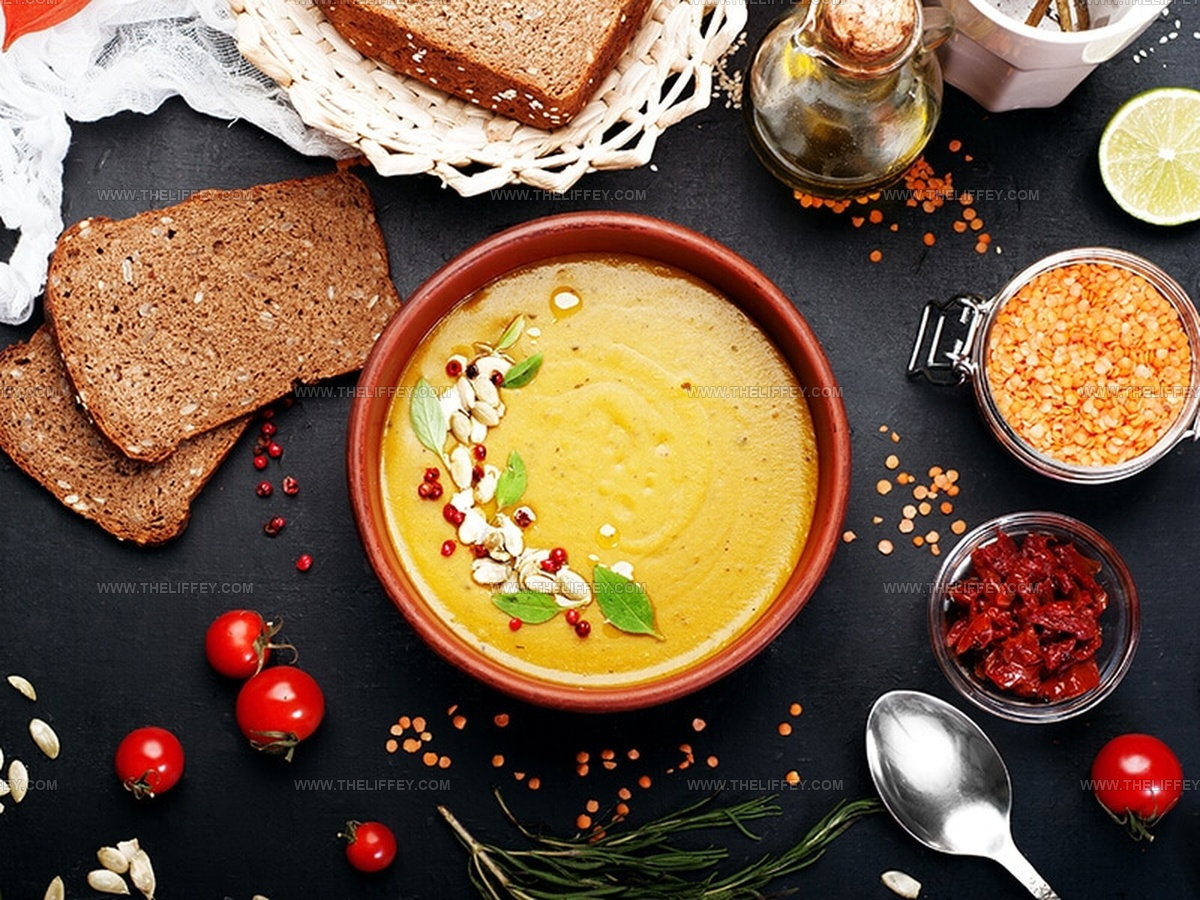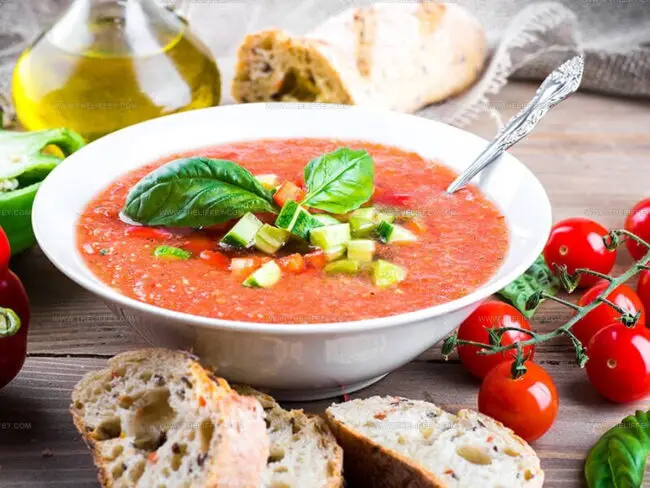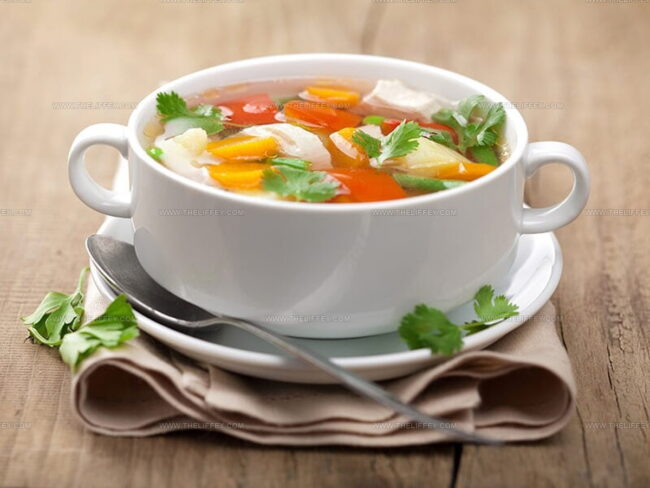Bisque or Soup: Know the Richer, Creamier Choice
Bisque vs. soup debates often spark lively discussions among food enthusiasts and home cooks alike.
Popular liquid dishes share many similarities but differ in key aspects of preparation and ingredients.
The rich, creamy texture of a classic bisque traditionally comes from crushed shellfish shells, while soups encompass a broader variety of styles and consistencies.
Many restaurants feature both options on their menus, allowing diners to choose based on preference or mood.
The French culinary tradition has given us precise definitions for these dishes, though modern interpretations sometimes blur the lines between them.
With seasonal ingredients and countless regional variations, you can find a perfect bowl for any occasion or taste preference.
Ready to dive deeper into the delicious world of these comforting bowls?
Thick Soup
Thick soups are opaque and creamy, achieved by adding thickening agents or pureeing ingredients. They offer rich, hearty textures and come in five popular styles:
| Type of Thick Soup | Description | Characteristics |
| Puree Soups | Made by blending cooked vegetables or legumes until smooth. | Smooth texture; examples include split pea and lentil soup. |
| Velouté Soups | Lightly thickened with roux and often combined with cream or egg yolks for silkiness. | Light, silky texture. |
| Cream Soups | Similar to velouté but always contain cream. | Rich, creamy texture; examples include cream of mushroom or tomato. |
| Bisques | Smooth, creamy soups made traditionally with shellfish, strained to remove solids. | Rich, luxurious seafood flavor. |
| Chowders | Chunky, hearty soups with ingredients like potatoes, corn, or clams, thickened with cream or milk. | Thick and filling with a chunky texture. |
Discover Soup and Its Fascinating History
Soup is a comforting and versatile dish enjoyed worldwide, made by simmering ingredients like vegetables, meats, grains, or legumes in water, broth, or stock to create a flavorful and nourishing meal.
Soup also comes in many varieties across cultures.
It can be served hot or cold, ranging from light, clear broths to rich, creamy blends thickened with cream, rice, or grains. Soups can function as appetizers, main courses, or even remedies for colds and digestion.
Preparation methods vary from quick stovetop cooking to slow-cooker recipes that develop deep flavors with minimal effort.
History Of Soup
Hot soup has a rich history dating back to 20,000 BC in Jiangxi Province, China, where people made it by creating pits filled with water and heated rocks for boiling. The name we use today comes from Latin "suppa," which refers to bread soaked in liquid - a simple start to what we now enjoy in countless varieties.
For centuries, people called this warm comfort food "soupe" until the 1600s when the French language gave us the modern term "soup" that stuck around in our daily meals.
Types Of Soup
Soups come in many forms, with four main categories that include thin, thick, cold, and national or special varieties.
Thin Soup
Thin soups are clear, unthickened liquids that often serve as light starters or broths. They include two main types: passed and unpassed soups.
| Type of Thin Soup | Description | Characteristics |
| Passed Soups | Clarified broths strained multiple times to remove impurities. | Crystal-clear, rich, concentrated flavor, requires careful preparation. Example: Consommé. |
| Unpassed Soups | Basic savory liquids made by simmering meats, bones, or vegetables in water. | Clear, simple flavor, served alone or with toppings like vegetables or meat. Includes broths and bouillons. |
Slurp Your Way Through Soup’s Fascinating History
Soup stands out as a universally appealing dish that wins over folks of all ages, including those who are quite selective about their food choices. Most people reach for a warm bowl when they feel under the weather or just need something simple to fill them up.
The comforting warmth travels down your throat and seems to melt away any stress or illness. Many cultures around the world have their own special recipes that have been passed down through generations, showing how this humble meal brings people together.
From light broths to hearty stews, soups can match any mood or season while packing nutrients in an easy-to-digest form. That's why this timeless meal continues to hold a special place on dinner tables everywhere.
Cold Soup
Cold soups are served chilled and make great starters or light meals during summer, offering a cooling balance to spicy or heavy dishes. They often use gelatin, starch, or pureed ingredients to thicken and can be savory or slightly sweet. Here are some ideal example:
Cold soups are served chilled and make great starters or light meals during summer, offering a cooling balance to spicy or heavy dishes.
National or Special Soups
These soups are unique to particular countries or regions and often reflect local ingredients and cooking traditions. They can be thick or thin, hot or cold. Some examples are:
What Is Bisque?
Bisque belongs to the thick soup family, making it definitely a soup in culinary classification. However, while every bisque qualifies as soup, not all soups can be called bisques due to their distinct characteristics.
The word "bisque" has interesting origins worth noting. Traditionally made from shellfish like lobster, crab, or shrimp, bisque starts with roasting the shells to extract intense flavors.
These shells are simmered to create a flavorful stock, which is then strained to remove any solids, ensuring a smooth base.
The soup is thickened with cream, giving it its signature velvety consistency.
Some versions come with cognac (French wine). Plus, bisque stands apart from other creamy soups because of its use of shellfish and meticulous preparation.
Bisques Etymology
Bisque has a fascinating history that dates back several centuries. The exact origin of the word is unclear, but some believe it comes from the Bay of Biscay, a coastal area famous for seafood.
Another popular idea is that "bisque" comes from the French words "bis cuites," meaning "twice cooked," which refers to the traditional way of roasting shellfish before simmering them into a rich soup.
In the 16th century, bisque was a smooth, pureed soup made from game birds and was considered a luxury dish served only to the wealthy.
By the 17th century, bisque had changed to become a simple seafood soup made by fishermen, using whatever shellfish they had on hand. This humble version is the foundation of today’s bisques, with lobster bisque being the most well-known type.
Similarities Between Bisque and Soup
Comparing bisque and soup reveals two important similarities. Keep reading to explore their similarities.
Liquid-Based Ingredients
Both bisques and soups rely on a flavorful liquid base. For regular soups, this is often chicken, beef, or vegetable stock. In bisques, which are seafood-focused, a rich seafood stock is essential.
For example, shrimp bisque is best made using stock from boiled shrimp shells to capture deep seafood flavors.
Cooking Process
Boiling and simmering are fundamental methods used in making both soups and bisques. Many creamy soups, including bisques, are pureed to achieve a smooth texture.
This can be done using a food processor or blender, both of which effectively create the thick, velvety consistency typical of bisques.
Bisque or Soup: Finding Out Their Differences
All bisques fall under the soup category, but not all soups can be called bisques because of their differences.
The table below gives you a handy summary of how these two dishes compare and differ from each other.
| Feature | Bisque | Soup |
| Texture | Thick, creamy, gooey, and rich | Varies widely; can be creamy (pureed) or thin and liquidy |
| Thickening Agents & Ingredients | Mainly shellfish/seafood with vegetables; thickened with heavy cream, wine, or cognac | Made from various ingredients; thickened with cream, flour, grains, or none |
| When to Add Cream | Cream added early in cooking to build thickness | Cream added near the end of cooking if used |
| Serving Temperature | Usually served hot, sometimes cold | Can be served hot, cold, or at room temperature depending on type |
| Accompaniments | Often served with milk, cream, and saltine crackers | Usually served with bread slices or sometimes alone |
| Garnishing Options | Garnished with herbs and small shellfish pieces | More diverse garnishes including herbs, nuts, and various toppings |
Texture
Bisques are known for their rich, creamy, and velvety texture, achieved through blending and thickening to create a smooth, luxurious consistency.
In contrast, soups vary widely in texture. Some soups share this creamy quality, like pureed vegetable soups, while others, such as clear broths or consommés, are light and watery with no thickening agents. So, while bisques are always creamy, soups can be either thick or thin.
Thickening Agents and Ingredients
Bisques are traditionally made with shellfish (like lobster or crab) and vegetables, thickened primarily by heavy cream and sometimes enriched with wine or cognac to boost flavor and texture.
Other soups use a broad range of ingredients (meat, seafood, vegetables) and may be thickened with cream, flour-based roux, pureed grains or legumes, or remain unthickened.
Timing of Adding Cream
In bisque preparation, cream is typically incorporated early during cooking to build its signature thick, smooth texture.
Conversely, many creamy soups add cream near the end of cooking to finish the dish, preserving the cream’s delicate flavor and preventing curdling. This difference reflects bisque’s methodical layering of richness versus the finishing touch approach in other creamy soups.
Serving Temperature
Bisques are most often served hot, highlighting their comforting, warming nature, though some variations are chilled.
Soups can be served hot, cold, or at room temperature, depending on the type; for example, gazpacho is served cold while many broths are hot.
Accompaniments and Garnishing
Bisques are commonly paired with cream, milk, or saltine crackers to complement their richness. Most soups are served with bread or rolls, though some hearty soups stand alone.
Garnishing for bisques tends to be simpler, often featuring herbs and small pieces of shellfish. In contrast, soups offer a wider range of garnish options, including nuts, croutons, cheeses, and varied herbs, thanks to their broader ingredient diversity.
Heartwarming Soup Recipe You Must Try
These five popular soup recipes have won many hearts and will satisfy your taste buds when hunger strikes. The recipes balance flavors perfectly while letting key ingredients shine through in each spoonful.
Chicken Consomme
Making chicken consomme at home requires just a few key ingredients - egg whites, vegetables, ground chicken, chicken stock, and seasonings.
While preparation doesn't involve complex steps, patience is essential as the cooking process takes about 6 hours to develop those rich, deep flavors.
Pureed Vegetable Soup
Making soup at home brings nutrition and comfort to your dinner table with minimal effort. All you need are your favorite vegetables, broth, seasonings, and a splash of lemon juice to create something truly delicious.
Once everything simmers together, simply blend until smooth for a perfect texture.
Cream of Broccoli Soup
Making it couldn't be easier since the recipe calls for just a few basic items: fresh broccoli, diced onion, a pat of butter, water, simple seasonings, a squeeze of lemon juice, and a swirl of heavy cream on top.
You simply need to grab your blender or food processor at the final step to whip everything into a velvety consistency that's thick enough to satisfy but light enough to enjoy any day of the week.
Lobster Bisque
Despite lobster being a pricey shellfish, this remarkable soup is worth trying at least once in your life.
Making it involves creating a rich stock by boiling the lobster, then mixing in carrots, onions, celery, tomato paste and other flavorful ingredients before pureeing everything until smooth.
Clam Chowder
Clam chowder stands out as a delicious American classic that anyone can whip up in their own kitchen. This rich, hearty soup combines tender clams, savory bacon, smooth cream, tasty broth, and chunky vegetables such as potatoes, carrots, and onions.
For an easy shortcut, canned clams work perfectly in this recipe.
Why Is Soup An Ideal Food?
These are reasons why that you should prepare and savor bisques and other types of soup.
Easy to Make
Soups are beginner-friendly and don’t require fancy kitchen tools or advanced skills.
Most recipes involve simple simmering on the stovetop, which means you mostly let the ingredients cook themselves while you focus on other tasks.
This makes soups a perfect option for quick, hassle-free meals.
Packed with Nutrients
Soups often combine nutrient-rich ingredients like meats, seafood, poultry, vegetables, and flavorful stocks. This makes them excellent sources of vitamins, minerals, and antioxidants that support your immune system and aid digestion.
Even simple broths, like bone broth, are packed with collagen and anti-inflammatory compounds that benefit gut health, skin, and joints.
Keeps You Hydrated
Because soups have a high water content, eating them helps maintain hydration without having to drink lots of water.
This is especially comforting during cold or dry weather, when staying hydrated is crucial but sometimes overlooked.
Cost-Effective
Most soups can be made affordably using basic, easy-to-find ingredients. While specialty soups like lobster bisque may be pricier due to premium seafood, many nourishing and hearty soups can be made on a budget, making them ideal for everyday meals.
Convenient and Long-Lasting
Soups store well in the refrigerator for several days and freeze beautifully for months, allowing you to batch-cook and save time later.
Just heat up a portion whenever you want, making soup an incredibly convenient and versatile meal choice.
Got Questions? We’ve Got Solutions
1. Is a bisque always made with seafood?
Traditionally, yes. Classic bisques are made with shellfish like lobster, crab, or shrimp. However, modern interpretations sometimes use other ingredients like tomato or mushroom while maintaining the creamy, smooth texture.
2. Why are bisques smoother than regular soups?
Bisques are pureed until completely smooth and then strained to remove any solids. They also contain cream which adds to their silky texture, while many soups have chunky vegetables or meat.
3. Can I substitute cream in a bisque recipe?
Yes, you can use half-and-half, coconut milk, or cashew cream as lighter alternatives. The texture might be slightly different, but you'll still get that signature smoothness bisques are known for.
4. Are bisques always served hot?
Most bisques are served hot, but some variations like tomato bisque can be served chilled, similar to gazpacho, especially during summer months.




John Conley
Founder & Culinary Storyteller
Expertise
Recipe Development, Culinary Writing, Home Cooking Techniques, Seasonal Ingredient Utilization
Education
Lane Community College, Eugene, OR
Certificate in Culinary Arts
Focused on foundational cooking techniques, kitchen safety, and menu planning.
Gotham Writers Workshop, New York, NY
Course in Food Writing
Explored the art of crafting engaging culinary narratives and recipe development.
John grew up where food meant connection: big bowls, warm kitchens, and meals that told a story. After earning his Certificate in Culinary Arts from Lane Community College and diving deep into food writing at Gotham Writers Workshop, he found his calling: turning everyday recipes into something worth savoring.
At The Liffey, John’s focus is all about crafting dishes that feel easy, honest, and full of heart.